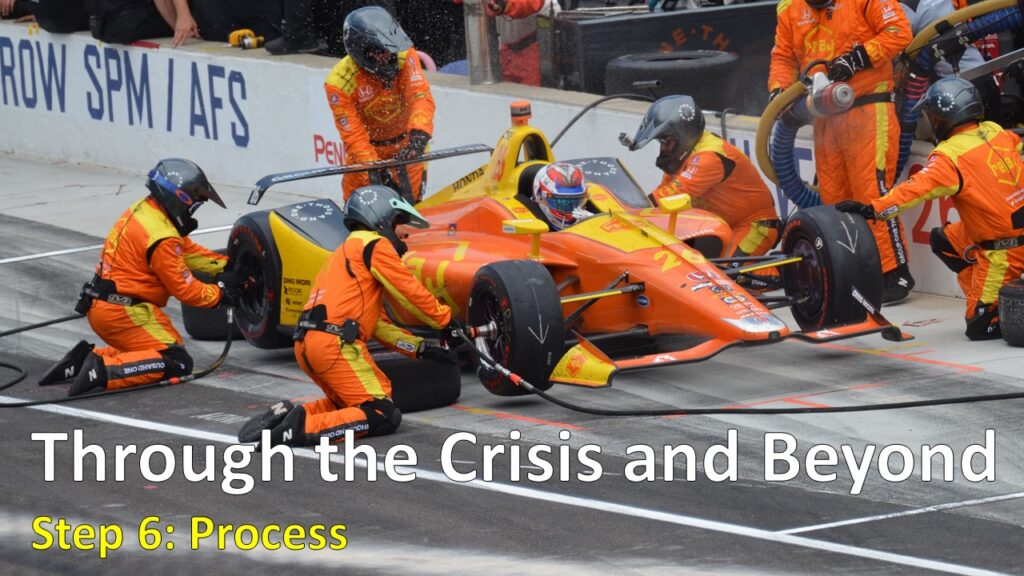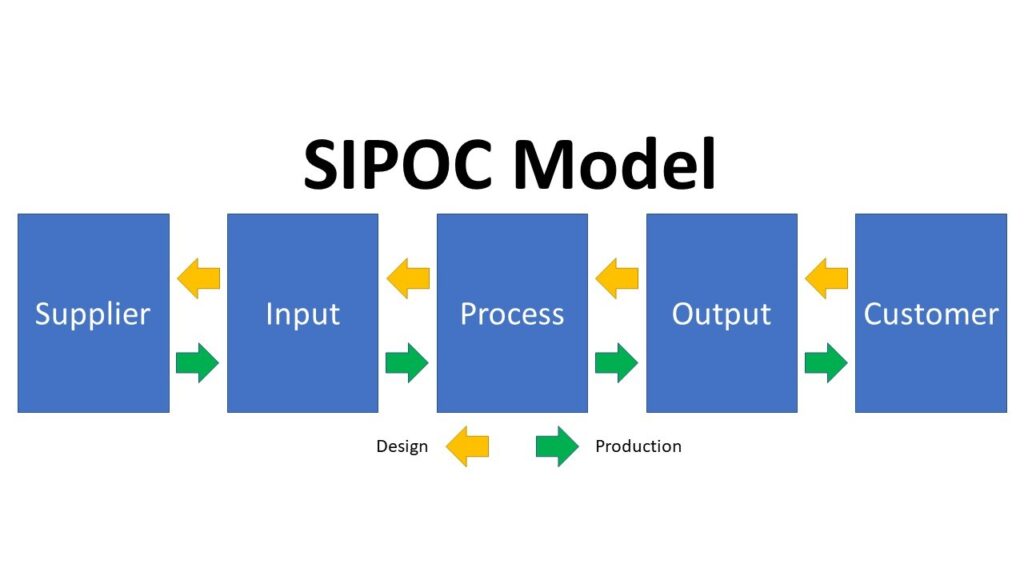Processes

This is the sixth in a series of articles designed to help you lead through the current COVID-19 crisis AND build and strengthen your organization for afterward.
In Step 5 we discussed People and how they are one of the two main ingredients in any organization.
You should be beginning to see how these steps are coming together. They are arranged in a sequence, but they interact. Life isn’t linear, neither is business.
In Step 6 we are going to discuss the other main ingredient… Processes.
By the way, it may seem odd to see a picture of a sporting event during this sportsless season. It obviously is from a prior year. But is there anything that screams PROCESS more than a motorsports pit stop!?
If you’re short on time, key takeaways and actions are listed at the end. Let’s continue…
Processes
Just as organizations can’t run without People, they can’t run without Processes either. And just like you need and want people in your organizations, you need and want Processes. Without Processes you will work in an environment of randomness and chaos and that is a prescription for unending management headaches. Can you say, H-E-Double Toothpicks
Remember, this dynamic duo of People and Processes comprise the two main components of any organization’s value creation engine.
The word “Process” is intimidating to some people. It sounds very engineering-like. But as creatures of habit, I bet you have many processes that you follow. How about the way you get ready for a Zoom call? Or the way you put your clean socks away after washing them? Even if you just throw them in a pile with unmatched pairs, that’s your process. But I also bet that you’ve intuitively figured out that to get consistent results, you have to follow a consistent Process.
To ease our engineering-terminology pain, there are many other words we could use in place of “Process,” such as: approach, procedures, methods, methodologies, techniques, operations, system, means, practices, activities, and so on. For our purposes, we will simply describe Processes as:
The steps we follow to accomplish work.
So, Processes really are nothing more than a series of steps. When your People follow the steps, you get the results you designed into the Process.
Process Design
Processes can be simple or complex. They can produce both products and services. And from a management and leadership perspective, the more complex a process is, the harder it is to manage. So, Simpler = Better. Although, sometimes simpler is harder to come up with.
French philosopher and mathematician Blaise Pascal is often credited with writing in a letter, ‘If I had more time, I would have written you a shorter letter.’ [paraphrased translation] It’s a little counterintuitive at first. But thinking a little deeper we see he was acknowledging and apologizing that if he had spent more time thinking about his message, he could have communicated it using fewer words.
It’s the same way with Processes. If we spend the time up front designing them, they can be made to operate simpler yet just as effective. This often is recognized as the definition of Performance Excellence… efficient plus effective.

The SIPOC Model shows the macro form of a Process from end-to-end. This is a universally recognized and useful model for designing processes AND running them.
In designing Processes, begin with the end in mind. In almost all cases, the end means the customer, and every Process has a customer. The customer defines value, in other words, what they are willing to pay you for (external customer) or accept from you (internal customer). So, the customer gets to define the requirements of the product or service you are providing.
Once you understand the end requirements, then you decide what output you can provide that will meet those requirements. Then, what process will produce that output. Then, what inputs do you need for the Process. And finally, where will you get those inputs. When designing, the model flows right to left. When running, it flows left to right.
Operationalizing Your Processes
Some processes are designed well, few are perfect from the start. They need to be tested and refined before being put into full use. Preferably tested on a small scale first. You pilot it before going full live because there are interactive effects in the real world that you can’t always envision during the design phase.
While you are piloting, observe the process in action. Gather data from it. Then improve it based on what you learned.
Standardizing Your Processes
Once you are certain that the Process is capable of always meeting the customer’s requirements, then standardize it by documenting it, training the people who will be using it, putting it into use, and checking on it periodically.
It is important to document the Process. If you don’t write it down, then you don’t have a standard. If you don’t have a standard, you will be left with whatever everybody remembers of the process not what you intended for it to be and produce. You will suffer with random results and you will have nothing solid upon which to base further improvements.
Processes need to be documented. You don’t have a standard process if it isn’t written down.
Improving Your Processes
We’ll discuss improving your Processes in an upcoming article. Suffice it to say for now that continuous improvement is a best practice.
If you are certified by ISO or Joint Commission or accredited by any other industry or regulatory body, then you have defined your Processes, documented them, audited them, and maybe even improved them too.
A note for these current times: Be agile. As we descend into this virus crisis, we know we will ascend out of it. The world will be a different place afterward in some ways. Be ready and willing to adjust your processes to the current and post-virus customer requirements.
Key takeaways
First: Processes are the steps we follow to accomplish work.
Second: The simpler the Process, the easier it is to operate and manage.
Third: All Processes have customers. All customers have requirements. Your Processes need to meet your customers’ requirements.
Fourth: Unless you are a franchisee, or part of a large organization, you have to design your Processes. Test them out. Try them on a small scale. Scale them up. Continuously improve them.
Questions to ask yourself:
- Have I gathered, and do I understand, the requirements from my internal and external customers for all of our key processes?
- Who is designing our processes and how current are they in that area?
- Have we documented and standardized all of our Processes?
- Have we trained our people to operate our Processes to their highest level (100%)?
- What new processes will we need to have in place during and after the COVID-19 pandemic?
- Bonus: What Processes do you have at home? Which ones would you like to improve?
Steps to take:
- If this pandemic has caused downtime in your operations, take advantage of the opportunity to fine tune your processes and documentation. Use people who are most capable in an area to design the Processes for it.
- Likewise, review your training materials. If you updated a Process, you will need to update the training that goes with them.
- If this pandemic has not caused you downtime, it is still likely to cause a need for change upon recovery. Develop Process improvements and associated training plans for the post-virus world.
- Bonus: Improve one of your Processes in or around your home to the benefit of everyone, not just yourself.